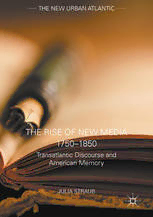
The Rise of New Media 1750–1850: Transatlantic Discourse and American Memory PDF
Preview The Rise of New Media 1750–1850: Transatlantic Discourse and American Memory
The New Urban Atlantic Series Editors Elizabeth Fay University of Massachusetts Boston Cambridge, Massachusetts, USA The early modern period was witness to an incipient process of transcul- turation through exploration, mercantilism, colonization, and migration that set into motion a process of globalization that continues today. The purpose of this series is to bring together a cultural studies approach - which freely and unapologetically crosses disciplinary, theoretical, and political boundaries - with early modern texts and artefacts that bear the traces of transculturalization and globalization in order to deepen our understanding of sites of exchange between and within early modern culture(s). This process can be studied on a large as well as on a small scale, and this new series is dedicated to both. Possible topics of interest include, but are not limited to: texts dealing with mercantilism, travel, exploration,immigration,foreigners,enablingtechnologies(suchasship- building and navigational instrumentation), mathematics, science, rheto- ric, art, architecture, intellectual history, religion, race, sexuality, and gender. More information aboutthisseries at http://www.springer.com/series/14425 JuliaStraub The Rise of New – Media 1750 1850 Transatlantic Discourse and American Memory JuliaStraub UniversityofBern Bern,Switzerland TheNewUrbanAtlantic ISBN978-1-137-58979-8 ISBN978-1-137-58168-6(eBook) DOI10.1057/978-1-137-58168-6 LibraryofCongressControlNumber:2017936748 ©TheEditor(s)(ifapplicable)andTheAuthor(s)2017 Thisbookwasadvertisedwithacopyrightholderinthenameofthepublisherinerror,whereas theauthorholdsthecopyright. This work is subject to copyright. All rights are solely and exclusively licensed by the Publisher,whetherthewholeorpartofthematerialisconcerned,specificallytherightsof translation, reprinting, reuse of illustrations, recitation, broadcasting, reproduction on microfilms or in any other physical way, and transmission or information storage and retrieval,electronicadaptation,computersoftware,orbysimilarordissimilarmethodology nowknownorhereafterdeveloped. Theuseofgeneraldescriptivenames,registerednames,trademarks,servicemarks,etc.inthis publicationdoesnotimply,evenintheabsenceofaspecificstatement,thatsuchnamesare exemptfromtherelevantprotectivelawsandregulationsandthereforefreeforgeneraluse. Thepublisher,theauthorsandtheeditorsaresafetoassumethattheadviceandinformation in this book are believed to be true and accurate at the date of publication. Neither the publisher nor the authors or the editors give a warranty, express or implied, with respect tothematerialcontainedhereinorforanyerrorsoromissionsthatmayhavebeenmade. The publisher remains neutral with regard to jurisdictional claims in published maps and institutionalaffiliations. Coverimage©GettyImages/ultramarinfoto Printedonacid-freepaper ThisPalgraveMacmillanimprintispublishedbySpringerNature TheregisteredcompanyisNatureAmericaInc. Theregisteredcompanyaddressis:1NewYorkPlaza,NewYork,NY10004,U.S.A. A CKNOWLEDGMENTS A book so profoundly concerned with memory would be incomplete withoutanexpressionofgratitudetoallthoseindividualsandinstitutions whosesupport of myworkhas been sovaluable overthe years. I would like to thank my colleagues at the English Department of the UniversityofBern,manyofwhomhaveprovidedmewiththeirguidance, understanding,andpracticalhelp.TheNorthAmericanliteratureresearch colloquium provided a valuable framework to test ideas, and I owe many thankstoAnnieCottier,NoraEscherle,StephanieHoppeler,LukasEtter, Ryan Kopaitich, and Viola Marchi, among others, for their feedback and constructivecriticism.PatriciaBieder,SimonReber,EttoreTrento,Rahel Braunschweig, and Sofie Beluhli were wonderful colleagues and student assistants;MonikaIseliFelderandHilarySharpsolidrocks,visitstowhose office often put a smile on my face; Irmtraud Huber and Ursula Kluwick reliable colleagues and empathetic friends. Virginia Richter, Barbara Korte, Christine Göttler, and Thomas Claviez read early versions of this book and I thank them, the series editor, Elizabeth Fay, the anonymous readers at Palgrave as well as my editors at Palgrave, Ryan Jenkins, Allie Bochicchio, and Emily Janakiram, for their useful advice. Nia Stephens- Metcalfe and Joe Fruscione helped me polish the final manuscript. Much of its finesse is owed to their discerning eyes. I am most indebted to Gabriele Rippl for her unflagging support of my projects and ideas and her belief in my person over by what are now almost two decades of co-operation.Herintellectualfervorandprofessionalismareatrueinspira- tion.ThanksarealsoduetoMarkusHaas,whoseworkbehindthescenes enabled,among otherthings,fruitful discussionsover deliciousdinners. v vi ACKNOWLEDGMENTS I would like to thank the Swiss National Science Foundation for fund- ing a visiting fellowship at Corpus Christi College, University of Oxford, in 2010, and Lincoln College, University of Oxford, for hosting me as a visiting fellow in 2011. Thanks also go to the Swiss Academy of Humanities and Social Sciences and the “Forschungsstiftung UniBe” for financingresearchandconferencetripsthatmadeimportantworkforthis book possible. Conversations with Jared Gardner, Oliver Scheiding, Stefanie Lethbridge, and Tim Lanzendörfer provided helpful input. Erik Redling, Annika Bautz, Betiel Wasihun, Philipp Schweighauser, Ridvan Askin, Ina Habermann, and Agnieszka Soltysik Monnet gave me much appreciated professionalsupport overthe years. I would like to thank Jasmin Fallahi, Verena Nungesser, Michelle Shepherd, Astrid Pfeiffer, Jolyon Pawlyn, and Jarmila Mazel for being loyal friends and helping me put things into perspective. Thanks to Kaj-Gunnar Sievert, who excels at boosting my morale so effortlessly with his sheer patience and kindness, and to my mother Astrid Straub, my sister Simone, my brother-in-law Johannes as well as my brother Stephanandmysister-in-lawSimonewiththeiramazingfamilyforalways being thereforme. Parts of Chapter 3 have been previously published in an article titled “Virtual Museums in Early America:Transatlantic Magazine Culture and Cultural Memory” included in Annika Bautz and Kathryn Gray, eds. Transatlantic Literature and Transitivity, 1750–1850. London: Routledge/Taylor&Francis, 2017. 149–70. They are reprinted with permission. C ONTENTS 1 Introduction:BuildinganAmerican Memory ofLiterature, 1750–1850 1 2 RememberingLiterature inEarly America: Transatlanticism,CulturalMemory,and ItsMedia 13 3 VirtualMuseums:The Literary Magazine andTransatlantic PeriodicalCulture 29 4 OfGems, Beauties,andRelics:Anthologies inEarly America 67 5 EarlyFormsof Literary Historiography inAmerica: Literary HistoriesasNarrativeAnthologies 103 6 Conclusion 153 Bibliography 157 Index 189 vii L F IST OF IGURES Fig.3.1 TitlepageofTheNew-EnglandMagazineforAugust1758. “Other2—NoTitle.”TheNewEnglandMagazineof KnowledgeandPleasure1(1758):0_3.Thisimageoriginally appearedaspartofProQuest’sAmericanPeriodicalsSeries. Reprintedwithpermissionfromdigitalimagesproducedby ProQuestLLC.www.proquest.com 32 Fig.3.2 TitlepageofTheGentleman’sMagazine;andHistorical Chronicle7(1737).CourtesyofBodleianLibrary,University ofOxford.WikimediaCommons—https://commons.wiki media.org/wiki/File:GentlemansMagazine1737Vol7.jpg#/ media/File:GentlemansMagazine1737Vol7.jpg. 33 Fig.3.3 ProspectusforTheUniversalAsylumandColumbian MagazineMarch1790“FrontMaterial1—NoTitle.” TheUniversalAsylumandColumbianMagazine4.3(1790): 131.ThisimageoriginallyappearedaspartofProQuest’s AmericanPeriodicalsSeries.Reprintedwithpermission fromdigitalimagesproducedbyProQuestLLC. www.proquest.com 41 Fig.3.4 ProspectusforTheUnitedStatesMagazine,or,General RepositoryofUsefulInstructionandRationalEntertainment April1794.“FrontMaterial1—NoTitle.”UnitedStates Magazine1.1(1794):1.Thisimageoriginallyappearedas partofProQuest’sAmericanPeriodicalsSeries.Reprintedwith permissionfromdigitalimagesproducedbyProQuestLLC. www.proquest.com 42 ix x LISTOFFIGURES Fig.3.5 TitlepageoftheTheGentleman’sMagazineJanuary1789. “Cover.”TheGentleman’sMagazineandHistoricalChronicle 59.1(1789):1.Thisimageoriginallyappearedaspart ofProQuest’sBritishPeriodicalsSeries.Reprintedwith permissionfromdigitalimagesproducedbyProQuestLLC. www.proquest.com 48 Fig.3.6 TitlepageofTheColumbianMagazineJanuary1789. “Cover1—NoTitle.”TheColumbianMagazine3.1 (January1789):3.Thisimageoriginallyappearedaspart ofProQuest’sAmericanPeriodicalsSeries.Reprintedwith permissionfromdigitalimagesproducedbyProQuestLLC. www.proquest.com 50 Fig.5.1 AdvertisementforRufusGriswold’santhologiesinThe LiteraryWorldof23December1848.“Advertisement9—No Title.”TheLiteraryWorld3.99(1848):956.Thisimage originallyappearedaspartofProQuest’sAmericanPeriodicals Series.Reprintedwithpermissionfromdigitalimages producedbyProQuestLLC.www.proquest.com 148
